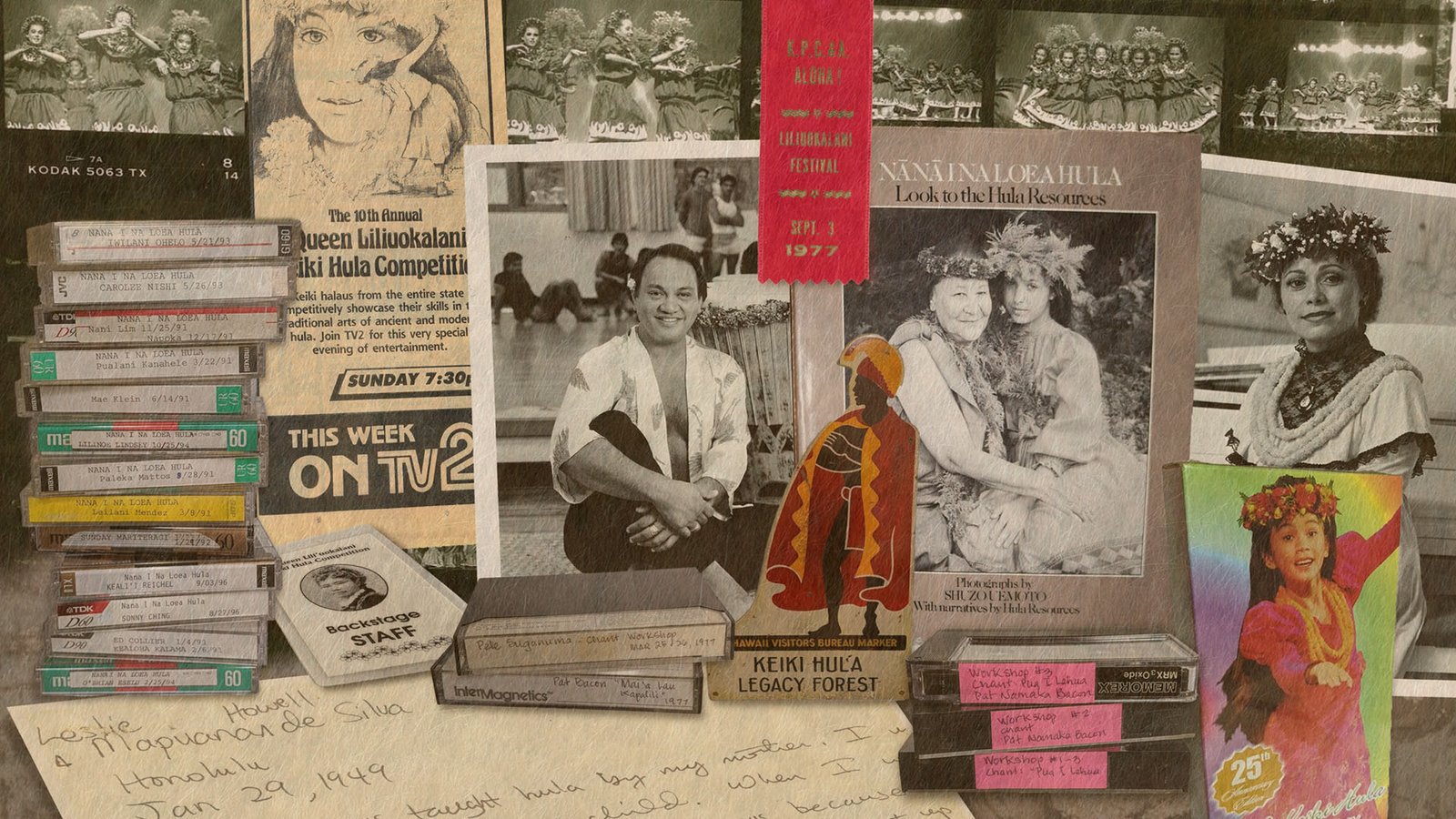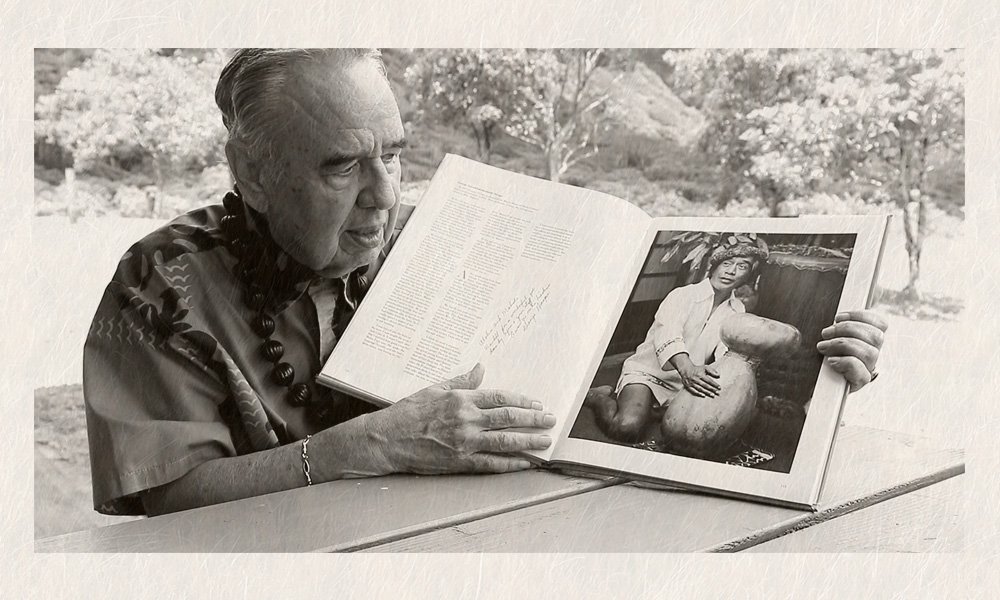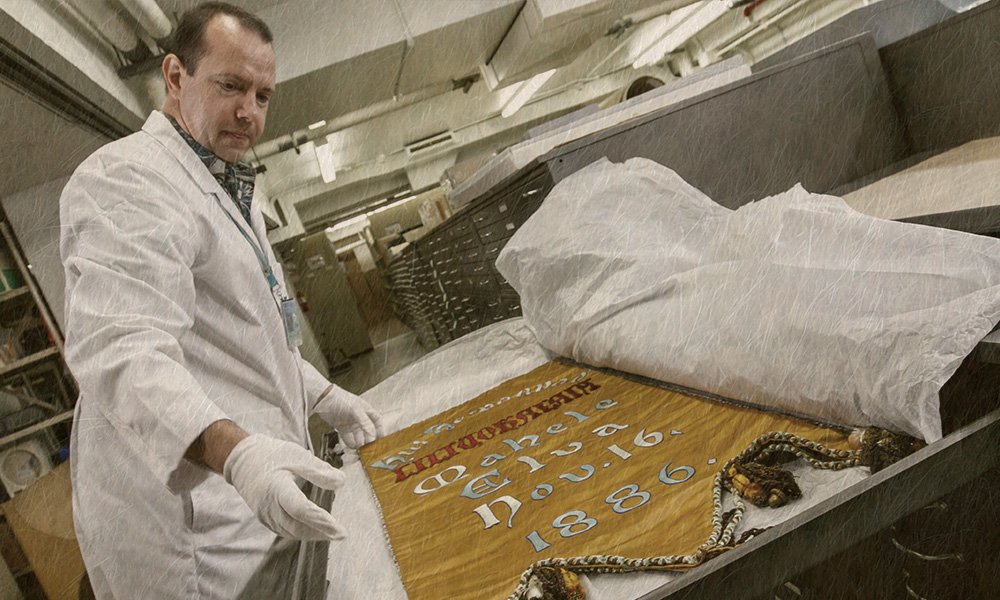

The library of materials originates from over 100 years of first-person hula knowledge directly collected / hoʻākoakoa and filed by the Kalihi-Pālama Culture & Arts Society. There is currently no other organization that has acquired an equivalent amount of resources. The physical media collection dates back to 1976, but the information precedes over a century.
As we move together into the next millennium, the future of hula rests in the safekeeping of these and other present-day resources. Their teachings will continue to live on and enrich the generations to come and will encourage kumu hula and their haumana to strengthen their foundation in hula and preserve this unique tradition of Hawai"i.

From the Second Hawaiian Renaissance
During a special time in the 1970s—a time of the Second Hawaiian Renaissance—Kahu Wendell Silva began a journey that would lead him to make contributions to the perpetualtion of Hawaiian culture. Along with Kumu Hula George Lanakilakekiahiali'i Na'ope, the two founded the Queen Liliʻuokalani Keiki Hula Competition that is now entering its 50th year.
Kahu Wendell Silva also began a way to document and collect the ʻike / knowledge of Hawaiʻi's Nā Kumu Hula. Along with the resource books are a treasure trove of audio recordings, handwritten and typewritten interviews, and transcripts, along with numerous newsclippings and photos—two Nānā I Nā Loea Hula Resource books were published by the work of Kalihi-Pālama Culture & Arts Society.

Nānā I Na Loea Hula Resource Books
What began as a project to collect hula ʻike / knowledge in the 1980s, the volumes of Nānā I Na Loea Hula Book One and Two are a treasure of hula resources that document Nā Kumu Hula telling their moʻolelo / stories in their own words and giving a glimpse into their lives, their training, and their own ʻike / their knowledge.
Published in 1984, Nānā I Na Loea Hula Book One is an 11x14 hard cover book that contains 152 pages and features portraits and moʻolele of 72 Kumu Hula. The cover jacket features Kumu Hula Mae Lobenstien and her granddaughter Maelia Lobenstein-Carter.
Nānā I Na Loea Hula Book One, published in 1997, is also an 11x14 hard cover book that contains 120 pages of 57 first-person narratives from kumu hula who share a common vision of preserving and perpetuating the art of hula. The cover jacket features Kumu Hula Pualani Kanaka‘ole Kanahele and Nālani Kanaka‘ole.
Kahu Wendell Silva Talking About the Nānā I Nā Loea Hula Books

Shuzo Uemoto
Nānā I Na Loea Hula Photographer
A respected photographer of exacting and timeless portraiture, who can capture and distill a myriad of nuances and moods, Shuzo Uemoto's portraiture is known for its cultural and spiritual sensitivities. He is also a dedicated experimenter whose focus is on unconventional photographic printmaking methods.
Shuzo has exhibited his works in exhibitions of local, regional, national, and international importance, and his work is included in private collections as well as the Honolulu Museum of Arts and The Hawaii State Foundation on the Culture and the Arts. His published works are in Contemporary Photographers of Hawaii, 1985, Collective Visions, SFCA; American Photographer, 1981- 87; Nana I Na Loea Hula Vol. I & II; Lessons of Aloha with Brother Noland 1999.
HINow Daily link to more about Shuzo photographing Kumu Hula

The Nā Kumu Hula Archive Project
Gathered together in the volumes of Nānā I Na Loea Hula One and Two is a treasure of current hula resources sharing a common vision of preserving and perpetuating the art of hula. Captured are the accounts of personal courage, individual hardships, accomplishments, and inner reflections. These individuals graciously share the history of their Hula foundations. Threads of commonality woven into the tapestry of human deeds and achievements in their art form await discovery in the Nānā I Na Loea Hula Volumes.
The Kalihi-Pālama Culture & Arts Society continues its quest to document and maintain the knowledge and wisdom of the Kumu hula and Hawaiian culture and is creating an online portal that captures and preserves through text, photos, video, and audio to maintain a searchable index and archive of Hawai’i’s rich culture through hula.

Lohe I Ka Leo - Hear the Voice Project
Lohe I Ka Leo: Hear the Voice is the initiative by the Kalihi-Pālama Cultute & Arts Society to create and publish a digital, multi-media library of first-person narratives of Kumu Hula histories as told by the Kumu Hula themselves. The cornerstone of our extensive collection includes voice recordings on magnetic cassette tapes of over 140 Kumu Hula, many of whom have died.
KPCAS used the technology of the time to capture these recordings, which are very raw but using today's digital tools, effort was made to clean up the recordings as best as possible. The cassette tapes were converted into digital AIFF files and will be made available in the archive within the corresponding Kumu Hula thatʻs voices were recorded. Their intent was to use the recordings to create printed text for the Nāna I Nā Loea Books but with today's technology these legendary Kumu Hula's voices can be heard and shared with a larger audience.

PARTENERSHIPS
The Hawai‘i State Archives
A division within the Department of Accounting and General Services, the Hawai‘i State Archives’ mission is to ensure open government by preserving and making accessible the historic records of state government and to partner with state agencies to manage their active and inactive records.
The Kalihi-Pālama Culture & Arts Society is partnering with the HAwai'i State Archives to ensure that the 40-year-old collections of the material generated from the Nānā I Nā Loea Books can be well maintained and preserved.

PARTENERSHIPS
H.T. Hayashi Foundation
The H.T. Hayashi Foundation is a family foundation guided by passionate commitment to the people of Hawaii.Established in 2005, the H.T. Hayashi Foundation reflects the legacy of visionary hotelier and philanthropist Herbert Takami “H.T.” Hayashi.
The H.T. Hayashi Foundation has supported KPCAS's efforts to bring the Nānā I Nā Loea Hula Books and their ʻika / knowledge into the digital age.

We believe in approaches to helping organizations achieve their goals. Providing counsel to all applicants and working to build capacity over multiple years.
MORE INFO
OHA is a semi-autonomous state agency responsible for improving the wellbeing of all Native Hawaiians (regardless of blood quantum).
MORE INFO
We champion every Hawaiian learner to explore their potential to lead our lāhui and inspire the world. Hānai i ke keiki, ola ka lāhui. Nurture the child and the lāhui thrives.
MORE INFO
Weaving our past and futures through the Humanities
MORE INFO